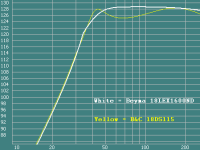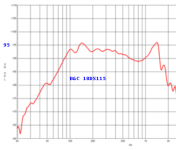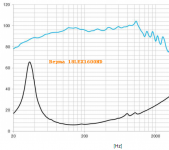Hi All,
This looks nice, both in appearance and specification:
PL&S
2017 – Beyma | LightSoundJournal.com
THIS SPEAKER IS A TRIBUTE TO THE CITY OF BARCELONA | Beyma Newsletters
LOW & MID FREQUENCY 18LEX1600Nd | Beyma
The BIG question - how much will it cost? I'm thinking it will be approaching £450.00GBP...
Cheers, Carl.
This looks nice, both in appearance and specification:
PL&S
2017 – Beyma | LightSoundJournal.com
THIS SPEAKER IS A TRIBUTE TO THE CITY OF BARCELONA | Beyma Newsletters
LOW & MID FREQUENCY 18LEX1600Nd | Beyma
The BIG question - how much will it cost? I'm thinking it will be approaching £450.00GBP...
Cheers, Carl.
B&C Speakers
B&C has released the 18DS115.
A low Qts of 0.20 and a healthy Bl of 39.
Not far from a 8 ohm version of the mighty 18IPAL.
Perfect for front loaded horns, ROAR18 and similar designs.
The Beyma 18LEX1600Nd lacks Bl for any other use then open baffle or bass reflex. Are they Bl-phobic at Beyma?
B&C has released the 18DS115.
A low Qts of 0.20 and a healthy Bl of 39.
Not far from a 8 ohm version of the mighty 18IPAL.
Perfect for front loaded horns, ROAR18 and similar designs.
The Beyma 18LEX1600Nd lacks Bl for any other use then open baffle or bass reflex. Are they Bl-phobic at Beyma?
B&C Speakers
B&C has released the 18DS115.
A low Qts of 0.20 and a healthy Bl of 39.
Not far from a 8 ohm version of the mighty 18IPAL.
Perfect for front loaded horns, ROAR18 and similar designs.
The Beyma 18LEX1600Nd lacks Bl for any other use then open baffle or bass reflex. Are they Bl-phobic at Beyma?
I really like the direction of the new B&C woofers. The efficiency on these is exceptional and is coupled with a legitimate 15mm of excursion. The 8ohm has a normalized motor strength of 305 and the 4ohm is even higher at 350.
The Beyma linked is a completely different type of woofer. More old school. A little less geometric xmax and a normalized motor strength of only 97? I don't understand the use of NdFeb in the motor if it isn't utilized to generate a stronger field in the gap?
Wait till you have to lift the driverI don't understand the use of NdFeb in the motor if it isn't utilized to generate a stronger field in the gap?
18" drivers with neodymium magnets are often about half the weight of their ferrite counterparts, meaning about 10 kg/ 22 lbs. less to worry about.
Reflex box = 150L - fb = 42Hz - 24dB LR HPF @ 25HZ - Xmax not exceeded
Swings & roundabouts, as usualBoth seem good though ! Price will probably win

Where does the efficiency show up for the 18DS115? I would've expected it to be more sensitive above 100hz than an 18SW118.
Originally Posted by ErnieM
Where does the efficiency show up for the 18DS115?
It doesn't !
I would've expected it to be more sensitive above 100hz than an 18SW118.
So would a lot of people, i expect, & not just with this driver. BL is NOT everything, as many might think, or have been lead to believe !
Quoted sensitivities
Beyma 18LEX1600ND - 97 dB - B&C 18DS115 - 98.0 dB - See published graphs though !
Attachments
I simmed both drivers in the Xoc th18, Note that I used a 30hz 48db/BW HP and a 180hz 24db/LP on the high power measurements. Also note that I used the full 1700w nominal power handling on the B&C without reaching the xmax of 16.5mm. Is the B&C a good driver for the the Xoc TH18, no. But with a good TH design for the B&C it can be a hell of a horn.
B&C:
1w1m:
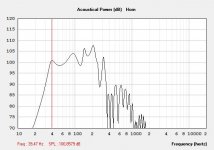
1700w @14mm xmax:
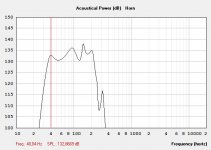
1700w diaphragm displacement:
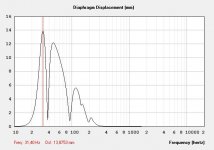
Beyma:
1w1m:
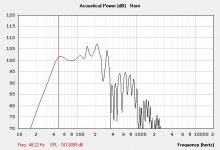
1200w @14.5mm xmax:
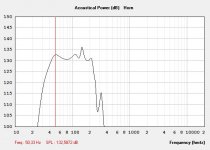
1200w diaphragm displacement:
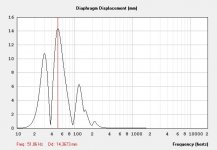
B&C:
1w1m:

1700w @14mm xmax:

1700w diaphragm displacement:

Beyma:
1w1m:

1200w @14.5mm xmax:

1200w diaphragm displacement:

While I've heard very low qts drivers struggle to reach low in extension, the 18ds115 has a low resonant frequency of 30 hz. I'm curious what alignment would work best to get decent output down to 30-35 with this driver? Bass reflex would not be my first guess. Is it possible to achieve a nice warm sound from these really stiff drivers?
AES Papers -- Official website of D.B.Keele
Don Keele has an excellent paper describing the importance of high Bl for high efficiency drivers.
35 "Comparison of Direct-Radiator Loudspeaker System Nominal Power Efficiency vs. True Efficiency with High-Bl Drivers," presented at the 115th Convention of the Audio Engineering Society, New York (Oct. 2003).
The B&C 18DS115 is designed for hornloading and the Beyma 18LEX1600Nd is designed for bassreflex.
You should not compare them in a 150 liter bassreflexbox. Its like racing a Caterpillar D11 with a Porsch 911 on a straight flat road and claiming that the Caterpillar D11 is a worthless vehicle because it lost that specific race.
Don Keele has an excellent paper describing the importance of high Bl for high efficiency drivers.
35 "Comparison of Direct-Radiator Loudspeaker System Nominal Power Efficiency vs. True Efficiency with High-Bl Drivers," presented at the 115th Convention of the Audio Engineering Society, New York (Oct. 2003).
The B&C 18DS115 is designed for hornloading and the Beyma 18LEX1600Nd is designed for bassreflex.
You should not compare them in a 150 liter bassreflexbox. Its like racing a Caterpillar D11 with a Porsch 911 on a straight flat road and claiming that the Caterpillar D11 is a worthless vehicle because it lost that specific race.
Couple of things to respond to about my comments. The weight issue. Yes a neo motor can be much lighter compared to a ferrite based design when both are called to hit the same performance benchmarks. However in this case it should not require 10 extra lbs to produce this type of motor strength.
I said the DS drivers were very efficient and they are. Efficiency not sensitivity. Those are not the same thing by any means.
Not saying the Beyma is a bad driver at all but it's design choices confuse me a bit. Seems to be an old school large vented app driver which could've been made with a more cost effective, only slightly heavier ferrite motor. I don't know...makes me scratch my head.
I said the DS drivers were very efficient and they are. Efficiency not sensitivity. Those are not the same thing by any means.
Not saying the Beyma is a bad driver at all but it's design choices confuse me a bit. Seems to be an old school large vented app driver which could've been made with a more cost effective, only slightly heavier ferrite motor. I don't know...makes me scratch my head.
Closed box, then EQ to target, done. Output is determined by displaced volume, no matter how you get there.While I've heard very low qts drivers struggle to reach low in extension, the 18ds115 has a low resonant frequency of 30 hz. I'm curious what alignment would work best to get decent output down to 30-35 with this driver?
With low Qts drivers you'll need an amp with lots of voltage headroom but it will be rewarded with very well controlled sound. Low Qts means more velocity feedback inside the driver which helps precision -- just don't overdrive it (not likely with this huge Xmax).
While horns are nice, sometimes a simple vented box is all you need (or want), and this driver seems to be designed for that purpose. 127+dB out of a 300 L box that has extension down to and slightly below 35 Hz? This driver should be able to do it, if you have about 1.5kW on tap to drive it of course. Based on a HornResp sim of it used in a BVR-like alignment.
Note Beyma do have a similar "1600Nd" driver with a lower Xmax, but lower Qes and Fs too.
Note Beyma do have a similar "1600Nd" driver with a lower Xmax, but lower Qes and Fs too.
I said the DS drivers were very efficient and they are. Efficiency not sensitivity. Those are not the same thing by any means.
You're right. Thought about it more after I posted.
I've been looking at the 18DS115 hard for a sealed bass guitar woofer running off a couple channels of a PLD4.5.
The Beyma looks like a decent driver, but more of a showpiece rather than a new benchmark in performance.
Couple of things to respond to about my comments. The weight issue. Yes a neo motor can be much lighter compared to a ferrite based design when both are called to hit the same performance benchmarks. However in this case it should not require 10 extra lbs to produce this type of motor strength.
I said the DS drivers were very efficient and they are. Efficiency not sensitivity. Those are not the same thing by any means.
Not saying the Beyma is a bad driver at all but it's design choices confuse me a bit. Seems to be an old school large vented app driver which could've been made with a more cost effective, only slightly heavier ferrite motor. I don't know...makes me scratch my head.
For decades Beyma has catered for the Reflex Market. Woofers housing Neodyminum magnets have a history of failing compared to woofers housing ferrite magnets under longterm high SPL usage in Reflex boxes. This is why they were not very popular when marketing tried to make them popular. So the extra weight used for the magnet is more of a security method to reduce failure (overheating issues). The Beyma 18 LEX 1600Nd are showing preliminary specs which can change before they are offered to the public. Thus far the parameters are close to the 18 G 550 which is their oldest model available to the public with more xmax.
Last edited:
- Status
- This old topic is closed. If you want to reopen this topic, contact a moderator using the "Report Post" button.
- Home
- Loudspeakers
- Subwoofers
- New Beyma 18LEX1600nd driver
